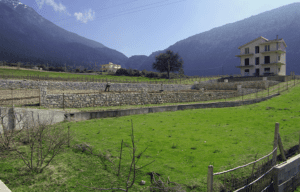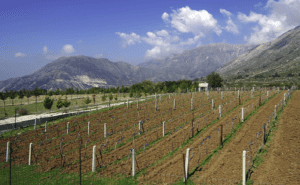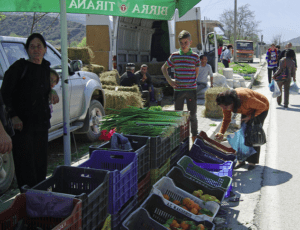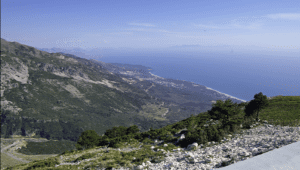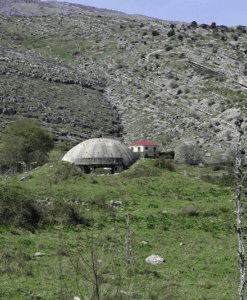We arrived in late March. It had been a very cold winter with the first snow for nearly thirty years. Many of the palm trees had been killed and the first impressions on a bright and sunny day was of a semi arid desert. Trees were yet to come into leaf, although by the time we left most of them were green again. Judas trees with their bright pink flowers were everywhere. Bright pink Herb Robert and white daisies were in flower, as well as bright pink daises which looked a bit like Osteospermum.
The Albanians are very much into flowers and there are plant nurseries on the edge of all the big towns selling a range of trees and shrubs in containers.
Over 75% of the land is mountains. These are serious mountains, many over 2000m tall with bare rock and steep gullies carved out by rain water. There are few roads through them. In March there was still snow on the tops.
The coastal plain is flat and much of it has been drained and reclaimed from the sea. Beaches overlooking the Adriatic and Ionian Seas are coarse sand. Some are being developed as tourist destinations with towns like Vlora and Saranda building impressive promenades along the front. These are lined with cafes and restaurants with tables with palm leaf canopies. With the palm trees, this gives a very tropical feel. Most tourists come from surrounding Croatia which has a high ethnic Albanian population.
It is still very much an agricultural community with small family farms, growing food. Fields are long and narrow and frequently unfenced. There are small haystacks by the farm buildings. On the slopes of the mountains, slopes are terraced to grow olives.
Many of the farms have small vineyards attached to them. They make small quantities of their own wine which is drunk by the family. They also make raki which is a very fiery distilled liquor.
The men are seen working in the fields. There are small stalls along the roads selling produce, mainly fruit and vegetables, although in the upland areas there are dried herbs (mountain tea and honey). The Saturday Markets in the small towns sell everything from bales of hay to chicks to clothes and shoes. The quality of the fruit and vegetables is excellent.
Sheep and cows graze everywhere, including along the roadside and there is often a shepherd keeping an eye on them. Chickens and turkeys run free around the farm houses and fields.
Towns like Berat and Gijirokastra are remarkable for their well preserved Ottoman houses from the C18th and C19th and narrow cobbled streets. The houses with their stone ground floors and whitewashed upper floors climb the hillside. Berat is often referred to as the “City of a thousand windows”.
Elsewhere, you are very conscious of communist block apartments which are often beginning to show their age. Running water is only available for ten hours a day so many of the buildings have large water storage tanks on the roof.
During Communist times many large industries were built round the edge of the cities, funded by the Chinese. Many of these sites are now abandoned. Over 700,000 concrete bunkers were built along the coastline and roads during the cold war and many still survive.
After the fall of Communism in 1991 there was uncontrolled development in the 1990s when large and very modern buildings sprouted up throughout the towns and countryside. Many of the buildings in places like Vlora and Saranda date from then.
There was increasing concern about uncontrolled development and the destruction of ancient monuments like at Lekursi Castle where most of the fortress was destroyed to build a new cafe, that there was a blanket ban placed on development. Buildings were left unfinished and some were even blown up and destroyed. Building is new permitted but there are very strict controls on any development.
Main roads around the country were good. Minor country roads off into the mountains are unpaved.
Albania used to have a good rail network built by Enver Hoxha’s government after the Second World War and it was the main means of transport linking urban and industrial centre. However after the collapse of communism and increase in car ownership, the network is in very poor condition and only two lines around Durres still struggle on.
Food in Albania is basically vegetable based and is good. breakfasts were a choice of homemade yogurt with cold meats, cheese, tomatoes, cucumber and olives with bread. There was usually a cake or sweet biscuits.
Lunches and dinner menus included salads, a variety of vegetable dishes, pasta and rice based dishes. Lamb is a speciality in mountain areas and is very good, although it tends to come out as big chunks of meat with lots of bone and fat. Goat is also available on some menus.
Albania is changing rapidly, so now is a good time to visit before it changes out of all recognition.
There are full details of my holiday with all my photographs “here.”:http://wasleys.org.uk/eleanor/otherholidays/albania/index.html
